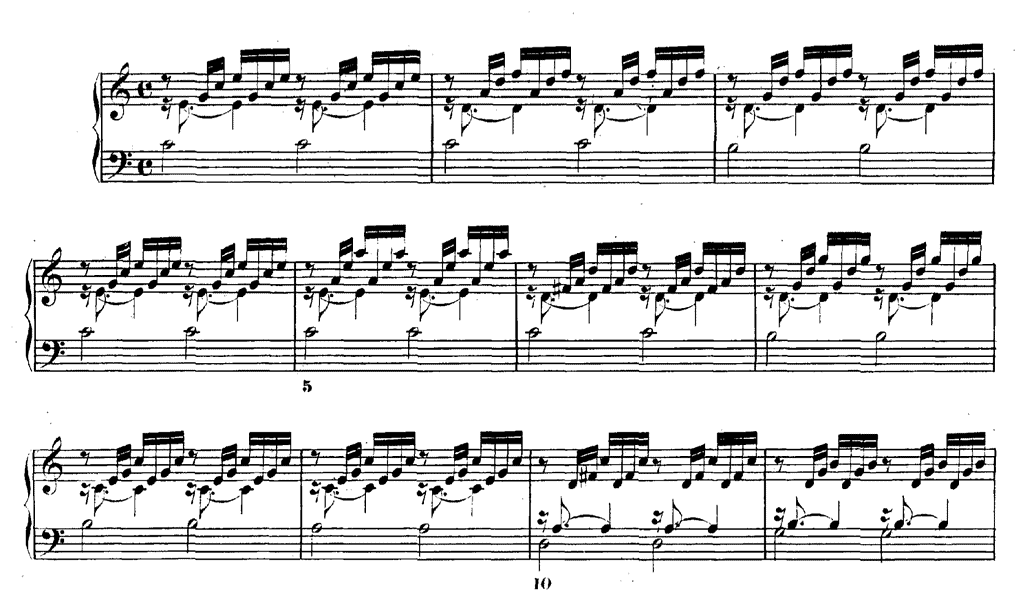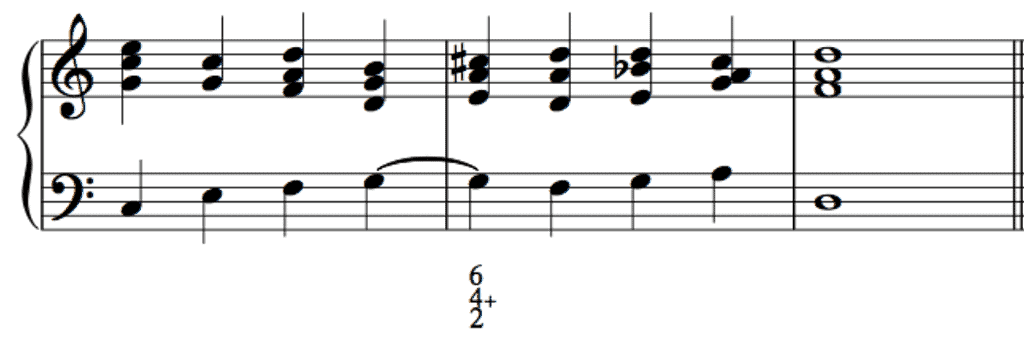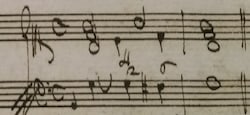In my essay Suspensions in the Upper Voice(s), I explain how a chord on a bass note that lasts two beats can be enriched with an on-beat dissonance in one or two voices.
In this essay, I will deal with suspensions in the bass. They are mostly set with a 4/2 sonority, to which the sixth can be added, and usually occur on ①, ④, ⑤ and to a lesser extent on ⑥.
While suspensions in the upper voice(s) remain ultimately a choice of the partimento student, however compelling their presence, a suspension in the bass can hardly be denied because of the tied or syncopated note.
In his book The Art of Partimento from 2012, Giorgio Sanguinetti formulates the following rule, with which all partimento masters undoubtedly agreed: “When the bass is tied, or syncopated, a suspension occurs in the bass; the suspended note must resolve downward by step and is accompanied by a second and fourth in the upper voices; a sixth may or may not be added” (Sanguinetti, 2012: 133).
The quality of the second, fourth and sixth depends on the scale step that becomes the suspensions, the mode (major or minor) and the melodic progression in the bass after the resolution.
Suspension on ①
When a syncopated ① descends a semitone to ⑦ (the leading note) and then rises again a semitone to ①, a partimento student learned that he had to play a 4/2 or 6/4/2 chord on the suspension. In both major and minor, the fourth is pure. As for the quality of the sixth, it depends on the mode. In a major key, the sixth will be mostly major (a whole tone above ⑤). In a minor key, the sixth will be mostly minor (half a tone above ⑤).

In the example above, play the second and third excerpts also in C major, with a♮ (and e♮).
When a syncopated ① descends a second and then descends further stepwise, the guideline was to play a 6/4+/2 chord, implying a scale mutation (modulation), on the moment of suspension.

Note that
- the moment of suspension functions as ④ in the new key
- a sixth chord instead of 6/5 chord must be played on the resolution of the suspension
- in minor, the resolution of the suspension should be chromatically lowered
- the preparation of the 4/2 suspension can be realized as a sixth chord, making the scale mutation more compelling (see the second beat of the third excerpt in the example above).
The following two examples show the score and the rhythmic reduction of the beginning of the first prelude from Johann Sebastian Bach’s Well-Tempered Clavier (Book 1), where both types of 4/2 suspensions occur:


While the above guidelines work in most cases, it must be mentioned that, when a syncopated ① descends a semitone and then rises back up a semitone, a 6/4+/2 chord on the syncopated ① may still be the better or the only choice. This occurs when the moment of suspension starts a modulation to the key a fifth higher than the previous one.

Suspension on ④
When a syncopated ④ descends a second, the guideline is to play a 6/4+/2 chord on the moment of suspension, a realization that is in fact already known thanks to the training of the descending rule of the octave (RO).

Note how the first four notes in both excerpts in the example above are realized according to the ascending RO, the next two to the descending RO.
Suspension on ⑤ in Major
When a syncopated ⑤ descends a second in a major key, either a 6/4/2 or a 6/4+/2 chord can be played on the moment of suspension. In case a 6/4/2 chord is played, the next chord on ④ can be either a sixth or a 6/5 chord. After a 6/4+/2 chord, a sixth chord on ④ is required.

A 6/4+/2 chord on the syncopated ⑤, suggesting a scale mutation, can obviously lead to a modulation:

Suspension on ⑤ in Minor
When a syncopated ⑤ descends a second in a minor key, C minor for instance, only a 6/4/2(♭) chord can be played on the moment of suspension. (Playing a 6♮/4♯/2♮ chord on the moment of suspension would result in (the suggestion of) D minor, a key that is too remote in the context.) As is the case in major, the next chord can be either a sixth or a 6/5 chord.

Suspension on ⑥ in Minor
When a syncopated ⑥ descends a second, the guideline was to play a (6/)4/2+ chord on the tied note. (This voicing leading is rather rare in major.)

Further Reading (Selection)
Demeyere, Ewald. On Fedele Fenaroli’s Pedagogy: An Update, in: Eighteenth-Century Music 15/2 (2018), 207-229.
Fenaroli, Fedele. REGOLE MUSICALI PER I PRINCIPIANTI DI CEMBALO, A Comparative Edition (V1.0), compiled and edited by Ewald Demeyere (Ottignies, 2021).
Gjerdingen, Robert O. Music in the Galant Style (New York: Oxford University Press, 2007).
Gjerdingen, Robert O. Child Composers in the Old Conservatories — How Orphans Became Elite Musicians (New York: Oxford University Press, 2020).
IJzerman, Job. Harmony, Counterpoint, Partimento: A New Method Inspired by Old Masters (New York: Oxford University Press, 2018).
Sanguinetti, Giorgio. The Art of Partimento — History, Theory, and Practice (New York: Oxford University Press, 2012).
